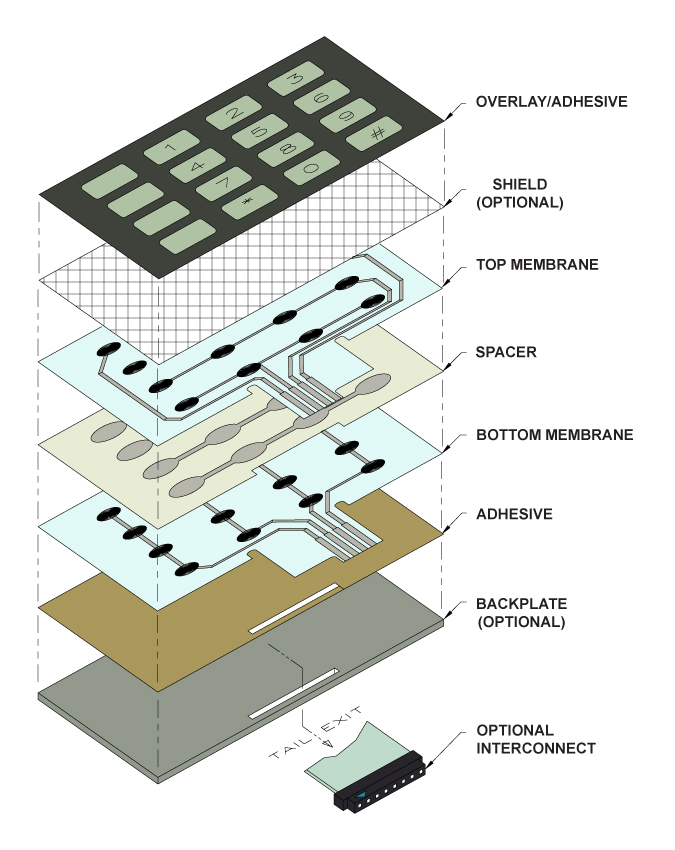Discover How a Membrane Switch Boosts Sturdiness and Functionality in Devices
Discover How a Membrane Switch Boosts Sturdiness and Functionality in Devices
Blog Article
Comprehending the Functionality of Membrane Layer Changes for Customer Interface Devices
The capability of membrane layer switches over represents a substantial improvement in customer interface layout, combining effectiveness with aesthetic adaptability. These buttons operate via a multi-layered structure that translates customer communications into electric signals, permitting both small designs and strength versus environmental variables. As markets increasingly prioritize user experience, comprehending the nuances of membrane switch technology comes to be vital. What ramifications do these advancements hold for future applications, and how might they redefine customer interactions throughout different gadgets?
What Are Membrane Layer Switches?
Membrane buttons are innovative interface gadgets that assist in customer interaction with electronic equipment. These functional elements are composed of numerous layers, including a graphic overlay, spacer, and a published circuit layer. The layout permits a seamless integration into different digital tools, boosting both the visual and useful elements of individual interfaces.
Membrane switches are typically utilized in a wide variety of applications, from household appliances to industrial equipment and clinical gadgets. Their building and construction commonly features a thin account, making them an optimal option for small styles. The tactile comments given by these switches can be engineered to fulfill certain user choices, ensuring efficient interaction in between the customer and the device.
Toughness is an additional substantial advantage of membrane buttons, as they are resistant to dirt, wetness, and chemicals, which boosts their life-span sought after settings. Furthermore, these switches can be personalized in terms of shape, size, and visuals style, permitting for branding and user-specific attributes. Generally, membrane changes stand for a useful solution for boosting customer experience in digital gadgets, combining functionality with aesthetic allure in an effective manner.
Exactly How Membrane Switches Work
Operating on an uncomplicated principle, membrane switches use a layered construction to sign up customer input efficiently. Each switch contains numerous layers, consisting of a printed circuit layer, a spacer layer, and a leading visuals layer, which are created to function together effortlessly. When an individual presses the leading layer, it presses the spacer layer, bringing the conductive components of the circuit layer right into contact with each other.
This call produces a shut circuit, indicating the gadget to perform a details function. The design permits numerous setups, consisting of tactile comments, which can improve the individual experience by offering a physical sensation upon activation. The products used in membrane layer switches often include flexible substrates, such as polyester or polycarbonate, which ensure resilience and resilience versus wear and tear.

Secret Benefits of Membrane Switches

One more significant advantage is their density. Membrane buttons are thin and lightweight, which enables producers to save area in their gadgets without giving up functionality. This attribute is particularly helpful in applications where weight and volume are critical considerations.
Additionally, membrane buttons are immune to dust, wetness, and chemicals, improving their sturdiness. This strength expands their life-span and minimizes the demand for constant replacements, resulting in price savings with time.
In addition, the responsive responses supplied by membrane buttons can be optimized to enhance user communication. They can consist of features such as raised buttons or distinct clicks, improving usability and user experience.
Applications Across Industries
Interface devices making use of membrane layer switches prevail in a large variety of sectors, showcasing their adaptability and performance. Membrane Switch. In the clinical sector, membrane layer buttons are important to tools such as analysis tools and individual monitoring systems, where their resilience and convenience of cleaning are crucial for maintaining browse around these guys hygiene requirements. Likewise, in the auto sector, these switches are employed in control panel controls and infomercial systems, providing a sleek and modern interface for users.
Additionally, the consumer electronic devices sector take advantage of membrane buttons in appliances and portable gadgets, where small layout and easy to use interfaces enhance individual experience. Industrial applications also utilize membrane layer changes for control board in equipment and automation systems, emphasizing their effectiveness and resistance to harsh settings.
In the aerospace and protection markets, membrane switches are used in cabin controls and equipment, where dependability and efficiency under extreme problems are extremely important. In addition, the video gaming sector significantly incorporates membrane buttons in controllers and gallery equipments, adding to an engaging customer experience. Generally, the flexibility of membrane layer changes allows their extensive usage throughout various markets, underscoring their importance in contemporary interface style.
Future Patterns in Membrane Layer Change Innovation

Additionally, using advanced products, such as polycarbonate and polyester films, is anticipated to climb, supplying enhanced longevity and resistance to environmental stress factors. These materials add to the general durability of membrane layer buttons, making them suitable for harsher industrial applications.
Moreover, the unification of smart innovation, including IoT connection, will certainly allow membrane buttons to interact with other tools and systems, assisting in a much more interactive customer experience. This pattern lines up with the expanding need for wise devices throughout various fields, from health care to consumer electronics.
Lastly, modification alternatives are expected to broaden, permitting makers to create bespoke remedies customized to details user requirements and preferences. These visit this website advancements will position membrane layer switches as important parts in the evolution of customer interface innovation.
Conclusion
In final thought, membrane layer switches stand for a critical development in interface technology, providing a dependable and versatile option see this website for varied digital applications. Their layered construction promotes small layout, while attributes such as tactile comments boost customer interaction. The toughness versus environmental aspects additionally strengthens their utility across numerous markets. As advancements in material science and touch sensing technologies continue, the functionality and applicability of membrane buttons are anticipated to increase, strengthening their value in contemporary digital gadgets.
Report this page